| The First Art Newspaper on the Net | Established in 1996 | Portugal | Monday, September 25, 2017 |
| |||||||
View of Zeitz MOCAA in Silo Square. Photo: Iwan Baan.
by Philippe Alfroy with AFP's Africa bureau network
JOHANNESBURG (AFP).- Contemporary African art has long been beloved by collectors in Europe and North America.
But now, such works are enjoying a renaissance among experts and the public on the continent itself. The opening of the largest museum of African contemporary art in the world in Cape Town on Friday is seen as a game-changer for the continent's arts scene. "Anything that is high profile and promotes really excellent contemporary African art is a really good idea and we'll all benefit from it," said Danda Jaroljmek, director of Nairobi's Circle Art gallery and founder of Art Auction East Africa. "It can only help all of us in what we're doing." Set in a 6,000 square metre former grain silo converted to premium gallery space at a cost of 31 million euros ($37 million), the Museum of Contemporary Art Africa's (MoCAA) collection will offer visitors a glimpse of hundreds of African pieces. The museum's opening also heralds the arrival of a much-needed local space where African sculptors, photographers and painters can have their works seen and enjoyed. Before, their works would typically have ended up under the hammer in a Western auction house or in the portfolios of private collectors in Europe, Asia or America. 'Gaps must be plugged' In May, British auctioneers Sotheby's sold its first consignment of African contemporary and modern art. Not to be outdone, the Vuitton foundation in Paris recently staged a major exhibition of art from the continent. Both were runaway successes that highlighted the growing interest around the genre -- as well as the growing demand among Western art fans and galleries for African art which is helping develop the continental art market. "Major museums, like the Pompidou Centre in Paris, the Tate Modern in London, or MoMA in New York have realised that they have very limited African contemporary and modern art offerings -- if any," said Clement Lecomte, an expert at the Cecile Fakhoury gallery in Abidjan. "For these museums that have a global outlook, these gaps must be plugged, so it's natural that they are turning to galleries on the continent. "Art follows money." As well as the Cecile Fakhoury gallery, several others are also thriving in Ivory Coast's commercial capital and cashing in on the desire for African pieces. Abidjan's Civilisations Museum reopened this year after a long-term closure caused by political instability and now features a contemporary art room. It includes work by celebrated sculptor Jems Koko Bi. The same trend is being seen in Dakar which will next year host the 13th edition of the Dak'Art biennial which celebrates the best of African contemporary art. "We're feeling a renewal of artists. We're observing a movement of works worldwide, in Europe and in the US," said one of Dak'Art's organisers who declined to be named. "Now the priority is to develop the movement within our own (West African) community, and in Africa." 'Shake-up the existing order' Danda Jaroljmek is seeing the same phenomenon is East Africa. Her gallery's revenues remain modest, but are picking up. "Things have changed radically in the last five years in Kenya and East Africa," said the gallery director. Marie-Cecile Zinsou who created the art museum in Benin that bears her name describes Nigeria as the driving force behind the revival of contemporary African art on the continent. "Something is clearly happening in Nigeria, especially with the increase in auction sales in Lagos. That will explode," said the Franco-Beninese entrepreneur. "The country has two essential factors for the development of art: democracy and a dynamic economy," she told AFP. "We invest in art if we can be persuaded that tomorrow will be better -- if not, it makes no sense." Zinsou described the newly opened Cape Town space as a "tremendous symbol", but acknowledges that her approach is starkly different to that of MoCAA. "It's all about private sector initiative. We still don't have a public equivalent, so it's the private sector making things happen in the cultural sphere," she said. "I hope that the success of this museum will prompt governments to shake-up the existing order." © Agence France-Presse
-+-+-+-+-+-+-+-+-+-+-+-+-+-
Art WorldZeitz Museum Debuts in Cape Town to High Hopes and Fierce Debate
A lot of fanfare, and a lot of questions, surround the ambitious new institution.
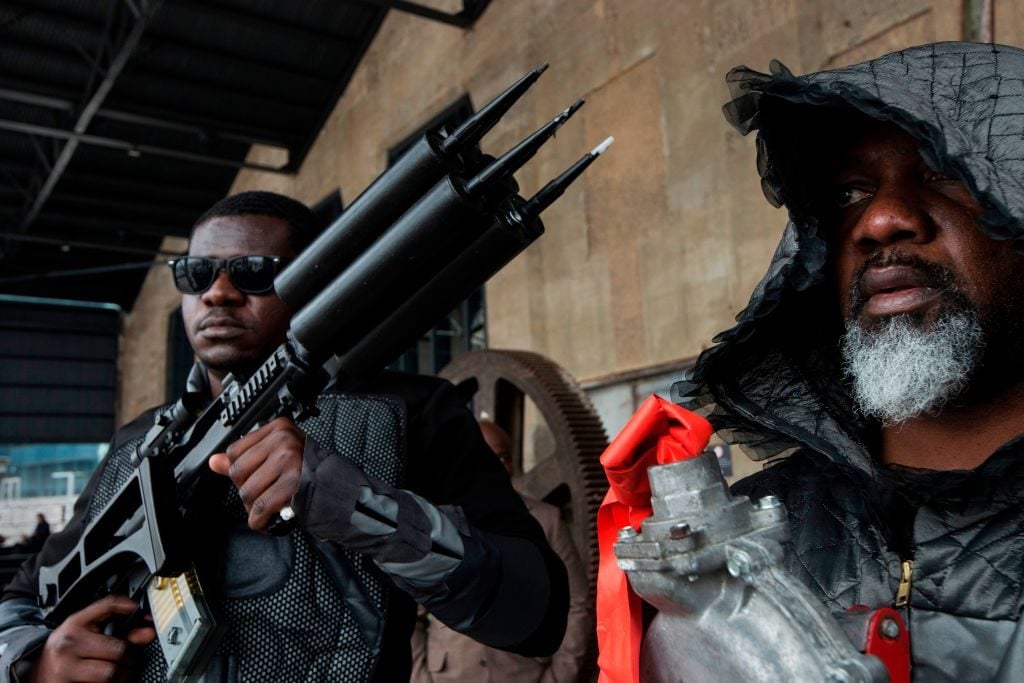
One would be hard pressed to find someone in Cape Town’s art world who doesn’t have strong feelings about the Zeitz Museum of Contemporary African Art (MOCAA), which officially opened its doors to the public last week.
Debates surround everything about the institution, from who it is intended to serve, to whose work will be on view, to its financial role within Cape Town and the V&A Waterfront district where it is located, to its relationship and responsibility to the rest of Africa. Before the first exhibition review was printed, Zeitz MOCAA managed to elicit a fury of feelings, opinions, complaints, and passionate discourse most museums will never see.
As the name of the new institution suggests, its founding collection is on a lifetime loan from German entrepreneur and former Puma CEO Jochen Zeitz. According to Zeitz himself, the controversy around the initiative is a good thing.
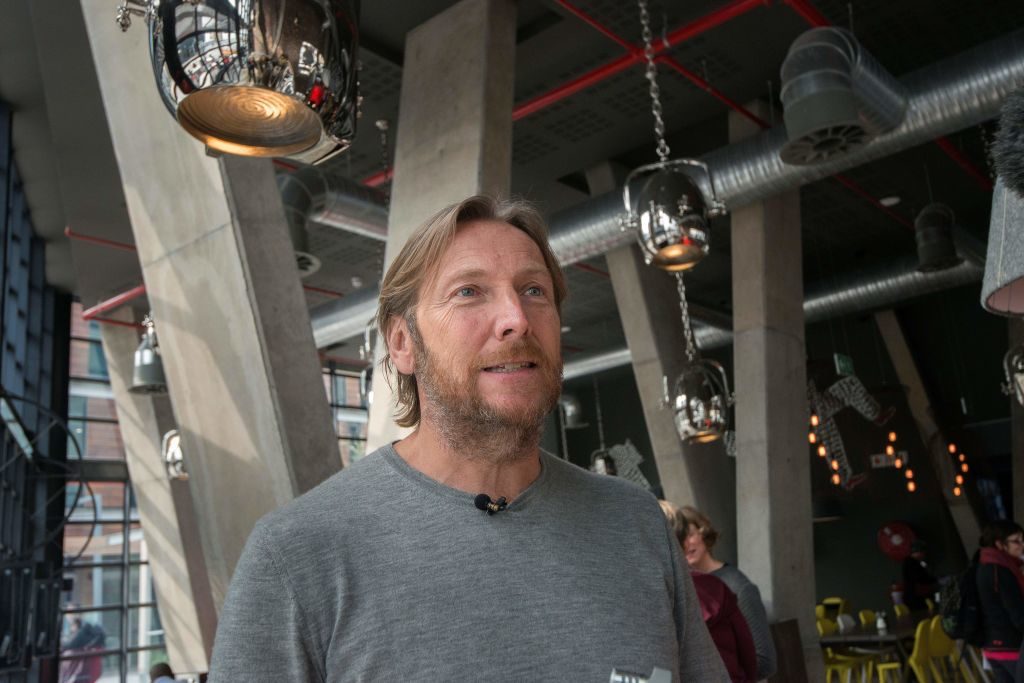
Patron of the Zeitz Museum of Contemporary African Art Jochen Zeitz speaks at the media opening of The Zeitz Museum of Contemporary African Art in Cape Town on September 15, 2017. Photo by Rodger Bosch/AFP/Getty Images.
“If people don’t have a critical viewpoint and aren’t talking about something, it’s irrelevant,” he says. “So the fact that people are talking about it—sometimes even without knowing enough to actually comment on it—shows that it’s a relevant institution already. From that point of view I look at this positively and think we are entering into a critical dialogue.”
The largest museum in the world dedicated to contemporary African art, Zeitz MOCAA is a glistening architectural feat, designed by British architect Thomas Heatherwick. Its 65,000 square feet of exhibition space are spread over nine floors in what was previously a series of grain silos. Classrooms, a performance space, a rooftop sculpture garden, and an on-site restaurant are now up and running, while the museum’s costume institute will launch later this year.
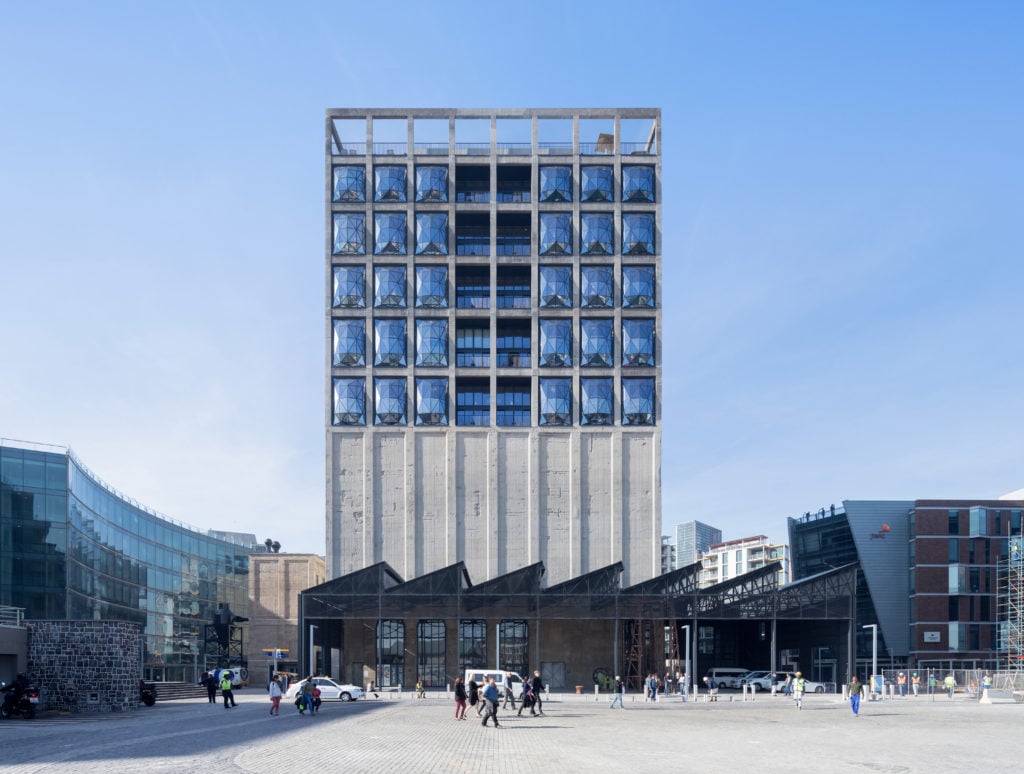
Zeitz MOCAA’s exterior at dusk, courtesy of Heatherwick Studio. Photo: Iwan Baan.
There are already more than 20 young people participating in a fully-funded year-long training program to bring young curators from throughout Africa to the museum.
Funded by Zeitz along with the V&A Waterfront—the corporation that since 1988 has been transforming Cape Town’s former harbor into what is now the most expensive real estate in Africa—with backing from GrowthPoint Properties and the Public Investment Corporation, the museum has been closely linked to capital since its inception. The V&A was planning a museum of some sort, and had even started working with Heatherwick before Zeitz and his collection entered the picture, but had no particular interest in, or knowledge of, the nuances of contemporary art.
“Growth Point and the V&A didn’t do the proper research or engage with the art world,” says Liza Essers, owner of the Johannesburg- and Cape Town-based Goodman Gallery. “They just did a deal, not really understanding how these things work globally.” Local galleries, curators, and artists found out about the museum at the same time as the wider public.
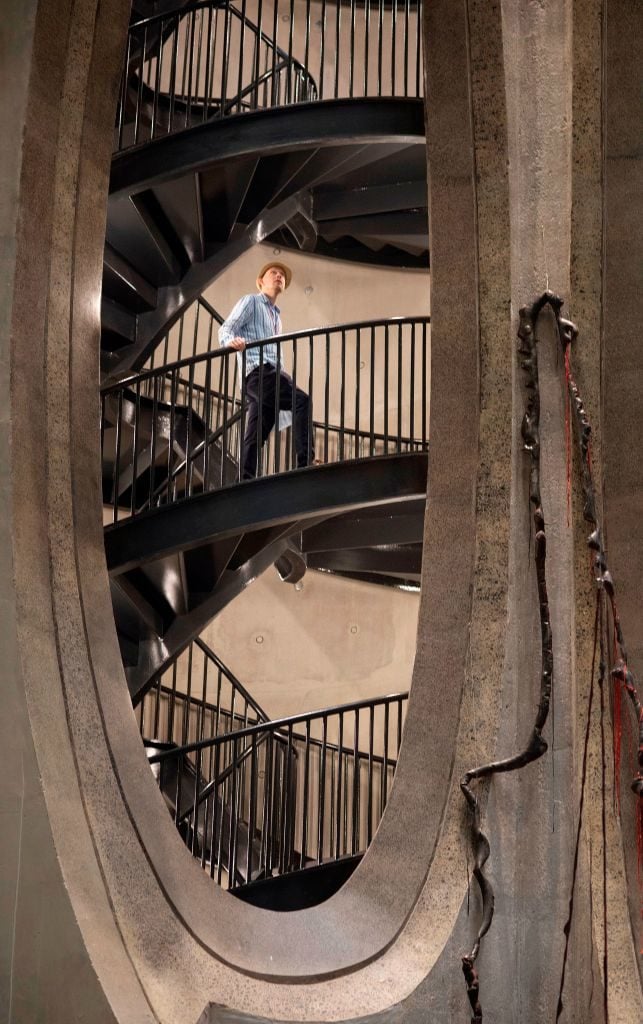
A visitor walks on a stairway in the Zeitz Museum of Contemporary African Art in Cape Town on September 15, 2017. Photo by Rodger Bosch /AFP/Getty Images.
The V&A Waterfront paid for the building’s $38-million redesign and will fund all exterior upkeep, with the museum responsible for the interior for the duration of Zeitz MOCAA’s 99-year lease on the building, at the rate of one South African rand (less than ten American cents) per year.
The relationship between real estate and art is nothing new—but the anxieties around it are tremendously heightened in the context of Cape Town, a city that, under Apartheid rule, was designed to keep black and white people separate.
With MOCAA tickets set at 180 rand ($14), the cost of admission is beyond the means of the majority of South Africans (it is free on Wednesday mornings and public holidays and for those under 18 years old, and there is half-price admission on Friday afternoons). Understandably, it’s difficult for people to think of this glittering museum—atop which sits the $900-per-night (for a basic room in the off season) Silo Hotel—as a financial asset for the exclusive Waterfront.
Zeitz sees the fees as justified. “This is a completely privately funded museum and we also want people to contribute to this institution so it is sustainable and we can do that by having people pay for a ticket,” he said. “That’s a very normal thing in museums around the world. It’s an attraction and it has a value.”
Indeed, it is the first museum on the entire continent with the capacity and resources to present large-scale exhibitions that would otherwise not be on view in Africa. This private museum is therefore expected to fill the function that public institutions in the rest of the world have long filled.
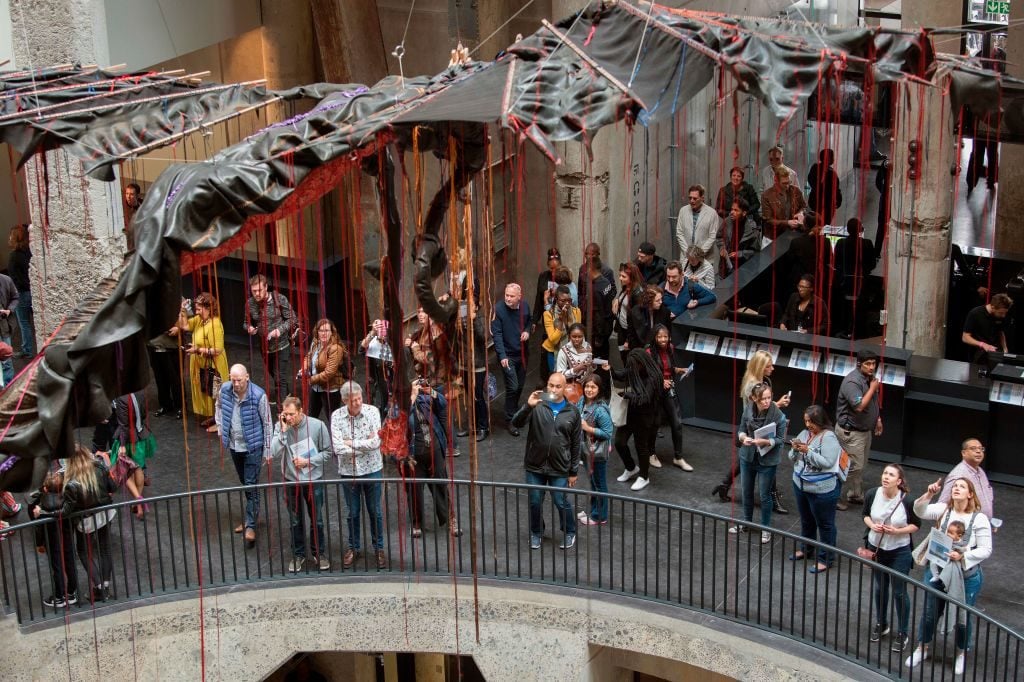
Visitors look at a sculpture by South African artist Nicholas Hlobo in the main hall of the Zeitz Museum of Contemporary African Art in Cape Town on September 22, 2017.
Photo courtesy Rodger Bosch/AFP/Getty Images.
Much has been made of the fact that the museum is helmed by white men—an obviously glaring issue in a country that is less than nine percent white (though the problem of racial inequality in the art world is far from unique to South Africa).
On a pre-opening walkthrough of the space, Mark Coetzee, director and chief curator of Zeitz MOCAA, explained that the ultimate goal is eventually to have the board reflect the racial demographics of South Africa. He also touted the museum’s democratic acquisitions process, in which all curatorial staff vote on all proposed works, thereby ensuring that no single voice outweighs the rest.
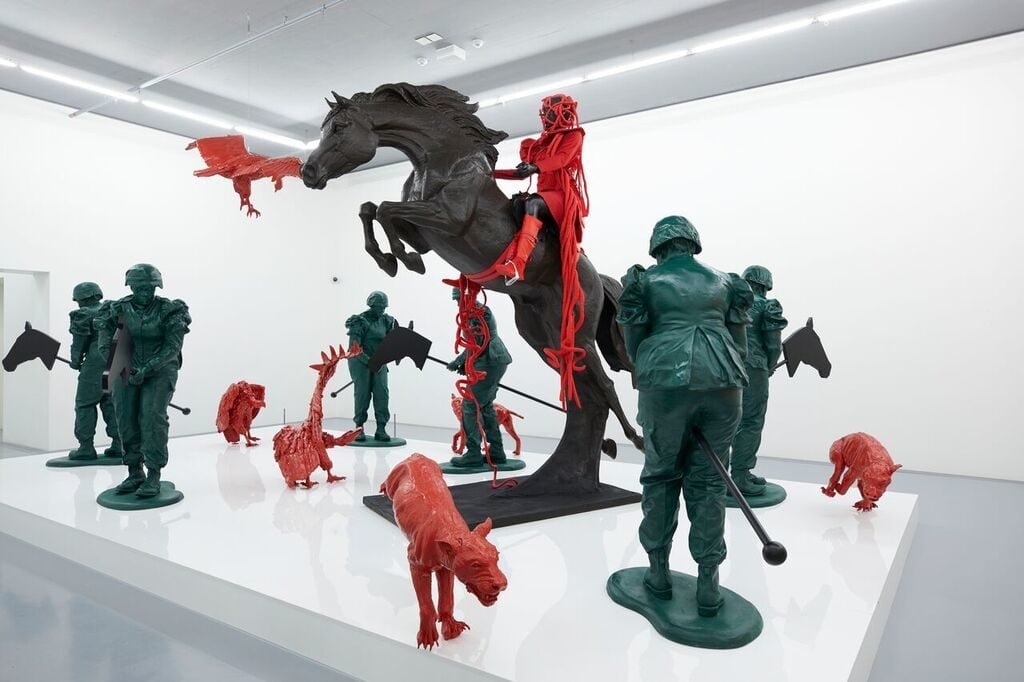
Mary Sibande’s In the midst of chaos, there is opportunity (2017). Courtesy of Zeitz MOCAA.
The balance between meeting the needs of Cape Town and the rest of Africa is also a challenge with which Coetzee must contend.
Osei Bonsu, a Ghanaian-British curator who is currently overseeing the “Satellite” exhibition at the Jeu de Paume in Paris, points out that relative to the rest of the continent, “the gallery system in South Africa has been quite well-structured to serve the community of collectors and commercial players working in the South African art scene.”
However, he continues, “it hasn’t always spread its tentacles into other regions of the continent, so we’ve ended up with a kind of asymmetrical system where South Africa represents everything that’s in development about the African continent and other regions are left in the darkness. I think the museum is a great step forward for South Africa, but I would hazard seeing it as a continental triumph.”
Founding a museum is rarely a smooth affair. In the United States, when New York’s Studio Museum was first getting started in 1968, the founding group included white MoMA trustees as well as black artists and educators—and they faced extensive hostility and condemnation at the outset.
Artist Romare Bearden refused to join the board because he was skeptical of white interests; works were broken under uncertain circumstances at the opening exhibition; and the founding director resigned within two months. It took some time, but the museum found its stride and is now one of the most important cultural institutions in the United States.
![Mayor of Cape Town Patricia De Lille [third from right], former archbishop Desmond Tutu [center] and Premier of the Western Cape Province Helen Zille [third from left] prepare to cut ribbons at the grand public opening of the Zeitz Museum of Contemporary African Art in Cape Town on September 22, 2017. Photo by Rodger Bosch/AFP/Getty Images.](https://news.artnet.com/app/news-upload/2017/09/Zeitz-Ribbon-Cutting-1024x683.jpg)
Mayor of Cape Town Patricia De Lille [third from right], former archbishop Desmond Tutu [center] and Premier of the Western Cape Province Helen Zille [third from left] prepare to cut ribbons at the grand public opening of the Zeitz Museum of Contemporary African Art in Cape Town on September 22, 2017. Photo by Rodger Bosch/AFP/Getty Images.
Or, as Liza Essers, the Goodman Gallery owner, told me, “This is a real opportunity to shift the discourse and to insert other perspectives into a Eurocentric art history. There are definitely issues, there is no question about that. But I think at this point we have to be supportive and we have to stand behind the museum. It’s up to all of us to make it a success.”
Follow artnet News on Facebook.
SHARE
Article topics
|



No comments:
Post a Comment